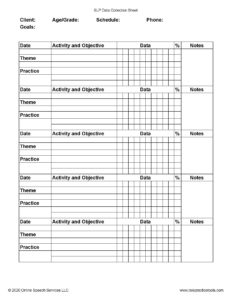The school year is in full swing! Whether you are working in schools or private practice, there is no time like the present to reset and get organized. When you are providing services via telepractice, it is even more important to stay organized. I’ve developed some time-saving tips and tricks that have helped me and I hope will help you, too.
My telepractice experience has been in schools and private practice, and the basic principles remain the same in both settings. In my last blog post, I shared some of the basics of the IEP process for SLPs in schools. After you’ve conducted your assessment, found the student eligible and started providing services, you must keep data so you can report progress on a regular basis (the school will determine how frequently progress must be reported). This is also an important component of providing evidence-based practice and making sure that your interventions are effective. If not, you will need to change course so your clients can make progress toward their goals. This same concept holds true in private practice. Whether your clients are private pay or services are paid by a third-party payer (i.e., insurance company, Medicaid, etc.), you will want and need to regularly provide progress reports to justify the need for continued services. It is especially rewarding to show clients the progress they’ve made so you can celebrate these milestones together.
In a nutshell, regardless of the setting, your process will look something like this:
- Create treatment plan.
- Implement treatment plan through direct intervention, consultation, and/or coaching.
- Document services provided.
- Assess the effectiveness of the intervention.
- Report and revise.
Planning and documentation are two of those inevitable time-consuming tasks that all SLPs must face. Depending on your work setting, you may spend a significant amount of your time on these tasks each week and may or may not be paid for that time. If not for that reason alone, many SLPs find themselves looking for ways to save time on these areas of their practice. So, how do you cut back on the time spent on these while not sacrificing the quality of services (and documentation) that you provide?
Let’s start with planning.
I work with clients of all ages, from early intervention through adults. According to ASHA’s SIG 18 telepractice survey, most SLPs in telepractice provide services in schools (e.g., working with children from preschool through 12th grade). So if you are among the more than 50% of SLPs working with school-aged children, this post is for you!
Once I started providing early intervention services via telepractice, I realized that I needed a plan! Telepractice is much different than working in a family’s home or center where you provide play-based therapy using the toys that are in the child’s environment. Sure, you can still have the family use the child’s toys, but you have less control over the environment. Enter my Themed Lesson Plans for Preschool and Early Intervention.
Once I realized that other early intervention and preschool SLPs were looking for time-saving lesson plans, I was motivated to share what I had been doing with my own clients with other service providers. So I decided to create themed lesson plans that follow a four-step format for each session:
- Read a book,
- Watch a video,
- Use an interactive website or app,
- Coach the parents.
Download a free Winter Themed Lesson Plan here.
 Download Free Lesson Plan
Download Free Lesson Plan
This format has been a LIFESAVER for me when working with my preschool and early intervention kids because it helps provide structure, the children are more engaged and the parents are more involved. I started with just eight themed lesson plans and am now have a full year of over 52 lesson plans.
By using my themed lesson plans, my planning process for early intervention and preschool literally takes me two minutes! This video demonstrates how I prep using themed lesson plans.
Depending on the child’s age, developmental level, and goal areas, I supplement the lesson plans with additional Boom Card decks. If you need help with finding or creating your own Boom Cards™, you can learn more about this in my Boom Basics Workshop.
For school-age children, however, I structure my lessons a little differently. I LOVE using Boom Cards™, so that is where I focus my planning efforts. You can read my Boom Cards Simplified blog post to see how I save precious planning time when searching for Boom Cards™. My structure for lessons with my school-aged (and some preschoolers) is usually this:
- Boom Cards™,
- Boom Cards™,
- Boom Cards™,
- Reward (usually while also working on a goal during an activity of the child’s choice).
- If the child is at home, I save a minute or two at the end of the session to talk with the parents. This is an opportunity to discuss the child’s progress and any home practice activities that I’d like them to keep working on.
Now that we’ve planned FUN and ENGAGING telepractice sessions, it is time to document. As much as I like to use digital resources for organizing, planning and materials, I still use good ‘ole pen and paper for data collection. Over the years, I have looked for data sheets online and usually end up writing in a couple missing fields. I’ve realized that there are five essential components for each data collection sheet and have used this to create my own data collection template.
What every telepractice SLP data collection sheet needs:
- Client’s name
- Phone number of e-helper
- Goals
- Activities
- Space for notes
You can download the FREE Data Collection Sheet here.

Tracking data in an organized data sheet makes it easy to write your SOAP notes in your online documentation system or EMR. You will then have the necessary data that you need to provide to schools, clients and third-party payers to determine the effectiveness of your services, report progress and make adjustments to your treatment plan.
I hope these time-saving tips will help you start your year on the right foot. I’d love to hear your time-saving tips in the comments.
If you are interested in getting blog notifications directly in your inbox, please subscribe! Also join our Members Only Area to get access to free materials and resources.